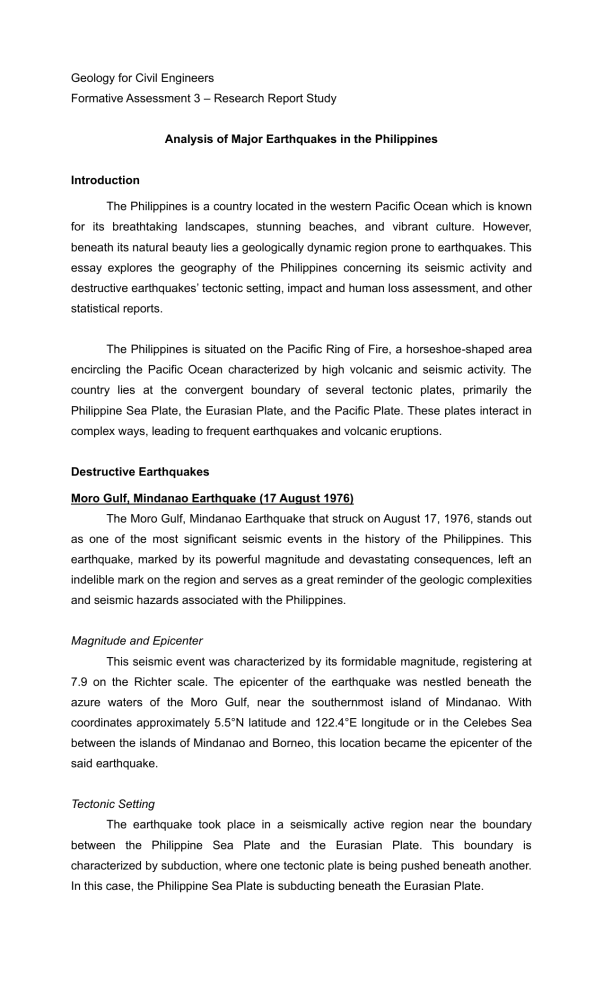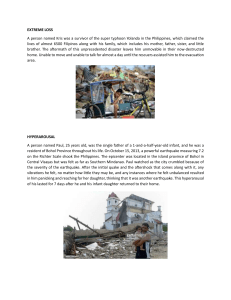
Geology for Civil Engineers Formative Assessment 3 – Research Report Study Analysis of Major Earthquakes in the Philippines Introduction The Philippines is a country located in the western Pacific Ocean which is known for its breathtaking landscapes, stunning beaches, and vibrant culture. However, beneath its natural beauty lies a geologically dynamic region prone to earthquakes. This essay explores the geography of the Philippines concerning its seismic activity and destructive earthquakes’ tectonic setting, impact and human loss assessment, and other statistical reports. The Philippines is situated on the Pacific Ring of Fire, a horseshoe-shaped area encircling the Pacific Ocean characterized by high volcanic and seismic activity. The country lies at the convergent boundary of several tectonic plates, primarily the Philippine Sea Plate, the Eurasian Plate, and the Pacific Plate. These plates interact in complex ways, leading to frequent earthquakes and volcanic eruptions. Destructive Earthquakes Moro Gulf, Mindanao Earthquake (17 August 1976) The Moro Gulf, Mindanao Earthquake that struck on August 17, 1976, stands out as one of the most significant seismic events in the history of the Philippines. This earthquake, marked by its powerful magnitude and devastating consequences, left an indelible mark on the region and serves as a great reminder of the geologic complexities and seismic hazards associated with the Philippines. Magnitude and Epicenter This seismic event was characterized by its formidable magnitude, registering at 7.9 on the Richter scale. The epicenter of the earthquake was nestled beneath the azure waters of the Moro Gulf, near the southernmost island of Mindanao. With coordinates approximately 5.5°N latitude and 122.4°E longitude or in the Celebes Sea between the islands of Mindanao and Borneo, this location became the epicenter of the said earthquake. Tectonic Setting The earthquake took place in a seismically active region near the boundary between the Philippine Sea Plate and the Eurasian Plate. This boundary is characterized by subduction, where one tectonic plate is being pushed beneath another. In this case, the Philippine Sea Plate is subducting beneath the Eurasian Plate. Impact The Moro Gulf earthquake had a devastating impact on the affected regions. It triggered a tsunami, which is not uncommon for large undersea earthquakes in this region. The tsunami waves caused extensive coastal damage, particularly in coastal communities around the Moro Gulf. The earthquake also had a devastating impact on the affected regions. It triggered a tsunami, which is not uncommon for large undersea earthquakes in this region. The tsunami waves caused extensive coastal damage including the houses of citizens or the community in general. Human Loss Assessment The earthquake and the resulting tsunami caused a substantial loss of life. The number of deaths is around 7,079-8,000 people. Aftermath of the Earthquake The Moro Gulf earthquake prompted significant humanitarian and relief efforts. Local and international organizations, as well as government agencies, were involved in aiding the affected communities. It also underscored the need for improved seismic monitoring and disaster preparedness in the Philippines, leading to increased efforts in earthquake research, early warning systems, and disaster management in subsequent years. Northern/Central Luzon Earthquake (16 July 1990) On a balmy day in mid-July 1990, the northern and central regions of Luzon Island, the largest island in the Philippines, were abruptly thrust into chaos by a powerful earthquake. The Northern/Central Luzon Earthquake, which occurred on July 16th, 1990, stands as a somber reminder of the seismic vulnerabilities of this archipelagic nation. Magnitude and Epicenter This earthquake was characterized by its formidable magnitude, registering at 7.8 on the Richter scale. The epicenter of the seismic activity was situated within Luzon Island, specifically near the town of Rizal, Nueva Ecija. The coordinates of the epicenter were approximately 15.3°N latitude and 121.1°E longitude. Tectonic Setting The Northern/Central Luzon Earthquake unfolded in the complex and dynamic tectonic setting of the Philippines. In this instance, the earthquake occurred in proximity to the boundary between the Philippine Sea Plate and the Eurasian Plate, where subduction, or the submergence of one plate beneath another, is prevalent. Impact Seismic waves radiated outward from the epicenter, causing severe shaking and structural damage. Buildings, bridges, roads, and other infrastructure were heavily affected. In particular, the historical buildings in the city of Baguio, which is a popular tourist destination, sustained significant damage. The rugged terrain of northern Luzon made it especially susceptible to landslides triggered by the earthquake. These landslides exacerbated the damage, blocked transportation routes, and hindered rescue and relief operations. The earthquake took a toll on communities, disrupting daily life and causing panic. The impacts were particularly felt in urban areas, as well as remote and mountainous regions, where access to aid and assistance was challenging especially due to road blockages. Human Loss Assessment The human toll of the Northern/Central Luzon Earthquake was around 2,412 people. Aftermath of the Earthquake In the aftermath of the earthquake, there was a concerted response to address the immediate needs of affected communities and to provide assistance to those in distress. This disaster also catalyzed broader efforts in disaster preparedness, seismic monitoring, and earthquake research in the Philippines. The University of Baguio, which got struck by this earthquake, was rehabilitated, while the land where Hyatt Terraces stood remains abandoned, which gives an eerie reminder of the earthquake. Bohol/Cebu/Siquijor Earthquake (15 October 2013) On the morning of October 15, 2013, the central Philippines experienced a profound and destructive earthquake that left an indelible mark on the region. This seismic event, known as the Bohol/Cebu/Siquijor Earthquake, would go on to reshape landscapes, disrupt communities, and prompt comprehensive efforts in disaster recovery and mitigation. Magnitude and Epicenter The earthquake was of significant magnitude, measuring 7.2 on the Richter scale. Its epicenter was located beneath the waters of the Bohol Sea, close to the town of Sagbayan, Bohol. The coordinates of the epicenter were approximately 9.9°N latitude and 123.6°E longitude. Tectonic Setting The Bohol/Cebu/Siquijor Earthquake unfolded within the broader context of the Philippines' complex tectonic setting. In this region, the Philippine Sea Plate is subducting beneath the Sunda Plate, resulting in active seismic activity. This particular earthquake occurred near the boundary between the Philippine Sea Plate and the Sunda Plate. Impact The earthquake caused extensive shaking that resulted in significant structural damage. Buildings, roads, bridges, and other infrastructure were severely affected. In Cebu City, for instance, historical churches and structures, including the Basilica Minore del Santo Niño, suffered notable damage. In the hilly and mountainous terrain of Bohol, the earthquake triggered landslides, exacerbating damage and hampering relief and recovery efforts. Landslides also posed a threat to communities in elevated regions. One distinctive aspect of this earthquake was its impact on the cultural and historical heritage of the region. Many centuries-old churches, some of which were designated as UNESCO World Heritage Sites, sustained significant damage or were partially or completely destroyed. This loss was deeply felt by the communities and had broader cultural and historical implications. Human Loss Assessment The human toll of the Bohol/Cebu/Siquijor Earthquake was around 222 people and the number of missing people is 8. Aftermath of the Earthquake Several flights from Cebu and Bohol airports and airport operations were put on hold as a response to check the safety status of the airport buildings. Mactan International Airport was later opened before midday, flights between Manila and Bohol were delayed due to temporary suspension of operations in Tagbilaran Airport for about three hours. By October 17, all operations of seaports in Bohol and Cebu were back to normal. One in every five households in Bohol had no electricity a week after the earthquake hit. In terms of number of barangays, according to the Department of Energy, 91 percent of 602 villages had their power restored. On October 24, Tagbilaran City was the only town in the province where energy was fully restored. By October 20, the water supply in 42 towns of Bohol was restored, but the towns of Calape, Cortes, Loon, Maribojoc, and Sagbayan still had a problem with their water supply. Summary Earthquake Moro Gulf, Northern/Central Name Mindanao Luzon August 17, 1976 July 16, 1990 October 15, 2013 7.9 7.8 7.2 Moro Gulf, Mindanao Northern Luzon Bohol Sea, near Date Magnitude Bohol/Cebu/Siquijor (Richter Scale) Epicenter Location Sagbayan, Bohol Tectonic Philippine Sea Plate - Philippine Sea Plate – Philippine Sea Plate Setting Eurasian Plate Eurasian Plate – Sunda Plate Impact Tsunami, widespread Structural damage, Structural damage, damage landslides cultural heritage impact, water and electricity interruption Human Loss 7,079-8,000 people 2,412 people 222 people dead and 8 missing people Aftermath Relief efforts, disaster Enhanced disaster Cultural heritage preparedness preparedness, road preservation, disaster blockages preparedness Conclusion These earthquakes collectively highlight the Philippines' vulnerability to seismic activity due to its location along the Pacific Ring of Fire. They also emphasize the importance of disaster preparedness, seismic monitoring, and building code enforcement to minimize the impact of such events on communities and cultural treasures. The lessons learned from these earthquakes have led to ongoing efforts to enhance resilience and mitigation strategies in the Philippines, with a focus on safeguarding both human lives and cultural heritage. As the country continues to grapple with its seismic risks, proactive measures in disaster management and seismic risk reduction remain paramount to protect the well-being and heritage of its people.








